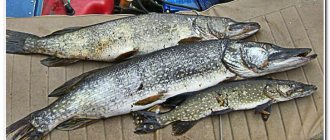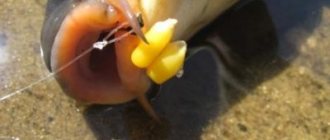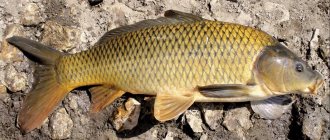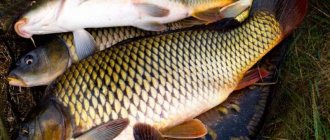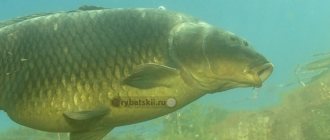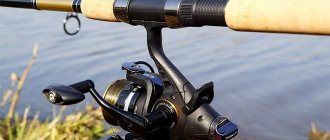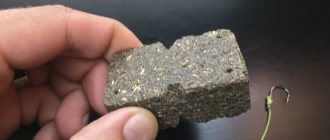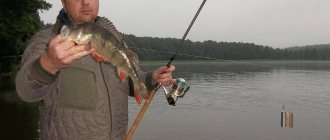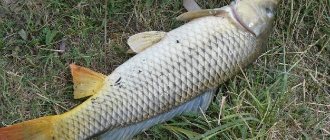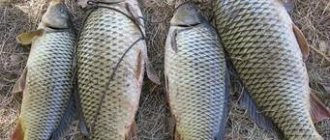Before moving directly to the consideration of the issues of catching carp, as well as the equipment necessary for this, we will briefly describe some of the features of this type of fish, which will allow us to more effectively analyze and select the necessary equipment in the future. In addition, it would be useful to identify the main habitats, as well as the optimal time frame for successful carp fishing, and only then begin to describe the gear in more detail.
Carp: description and features
Carp is a large freshwater fish, which according to its biological characteristics belongs to the carp family. In simple terms, this is the “wild form” of carp. However, in a number of European languages, as well as in Latin, they are called the same.
The fundamental difference between these closest relatives is their lifestyle: carp raised by humans in artificial conditions are much less mobile. This is the reason for the main species characteristic of the wild branch of the family - an elongated, block-shaped body, which helps the fish move faster.
As for other external features, the carp boasts rather large scales of a golden color, it has a dark back and bright red fins. The dorsal and caudal fins are equipped with a jagged saw-tooth ray that is dangerous to the hands; the fish has a large head and a high forehead.
The fish's mouth, framed by two pairs of whiskers, has a large upper jaw protruding above the lower jaw (lower mouth). This arrangement of jaws is a special adaptation of fish that feed on bottom organisms.
As already noted, carp is a fairly large fish. The size of an adult specimen can reach 100-120 cm, and its weight can be more than 20 kg. Average size – 50-70 cm, weight – 4-6 kg. The lifespan of this species is up to 30-35 years, but it stops growing at 7-8 years.
Among the main features of the carp’s lifestyle, we can name its heat-loving nature, which is mainly due to its southern distribution. It spawns at a temperature of 18-20 degrees. Most often, individuals are grouped in flocks, but large specimens can also live alone.
In summer, fish eat shoots of aquatic plants, frog and fish eggs. During the cold season, carp changes its diet to eating insects and invertebrates.
Habitats
The fishing location for carp is one of the most important aspects in achieving success, since this fish does not have the habit of frequently changing its location. A beginner’s mistake is choosing a place for fishing that is comfortable by human standards, but the object of the hunt prefers to avoid places where people often visit.
In the dark, a suitable position for yourself should be determined in a wild place located near the expected depths in the reservoir. We need quiet places with slow currents, heaps of stones, and snags.
On a summer day, you can find a fishing target near reeds and thickets of other aquatic plants, in fairly deep places. Wild carp prefer shallow water only at dusk or dawn.
Often the characteristics of “carp places” are as follows: significant differences in bottom relief, windbreaks, muddy, clayey bottom. An important trick useful in detection is the bursts at sunrise. Having arrived at the place in the dark and having discovered this phenomenon, one can safely hope for further success.
Selecting a location
To choose a good place for fishing, you need to arrive at the reservoir in advance, preferably before dawn.
In the early morning, the carp often appears in shallow water; it can enter bays and swim along the edge of the reeds. At the same time, the carp loves to play, jump out of the water, and the splashes of large fish on the surface are easy to notice and especially hear in the pre-dawn silence. If a fisherman is lucky enough to notice the game of a carp, he can, by studying the surroundings and the nature of the bottom using a pole or echo sounder, very accurately determine the boundaries of the territory where the carp lives. But even if this was not possible, based on a number of signs you can find a place where the probability of catching carp will be quite high.
First of all, you need to focus on changes in depth, holes and pools - typical habitats of carp. It can be found at the bends of a river with a sharply descending muddy bottom or a reverse flow. Nearby thickets of reeds, algae or snags are another sign of the carp’s habitat: the fish go there to feed.
A steep bank with trees and reed thickets hanging over the water may also be suitable as a fishing spot, but only if the depth there is at least 2-3 meters or more. Despite the fact that carp prefers quiet places, it makes sense to catch it in a strong current.
Firstly, it is usually quite deep there, and secondly, when using feeder equipment, the current carries the bait, and thus increases the chances of attracting fish to the bait site.
As a rule, places that meet all the listed requirements turn out to be less convenient for the fisherman himself. Using a feeder rig gives the fisherman more freedom of movement along the shore, but when fishing with a rod, he is very limited in his choice.
There is a chance to attract the carp to a more convenient place only if there is no strong current that will carry away the bait. However, the wait may take too long or even be in vain. Therefore, to successfully catch carp using a fishing rod, it is preferable to choose a place not according to your own taste, but to focus on the signs listed above.
Fishing season
According to the observations of experienced fishermen, carp bite throughout the warm season with some difference in activity. This period begins almost after the ice melted and the water began to warm up (the specific time depends on the climatic conditions of the individual region). At this time, carp are biting in the rivers.
He loves clayey edges under steep ravines, places with holes, snags and opposite currents. On the lakes the fish bites a little later, when the water temperature approaches 15-18 degrees. The final time frame of the season is considered to be late autumn, closer to the appearance of ice in places with a quiet current.
This fish bites most actively closer to autumn and until October, in the summer - more often at night, and at night the probability of catching a particularly large individual is greatest.
Guide to catching carp on a feeder
Carp is a heat-loving fish, so you need to catch it in the warm season - from mid-summer to mid-autumn. The best time of day to catch them is early morning and night. You can try your luck in the daytime, but the number of bites will be several times less.
Carp lives in pits with snags and algae. But throwing feeder gear into snags is not a good idea. When biting, the carp will begin to strongly resist and swim towards the snags, and the tackle will inevitably get tangled.
Therefore, you need to find a place not far from the fish habitat and lure the carp out using a feeder. A good place is the edge upstream. The depth of such places can be from 3 to 8 meters. The edges are the place where the carp goes to find food. It is advisable that the edge be located in a quiet place far from the shore.
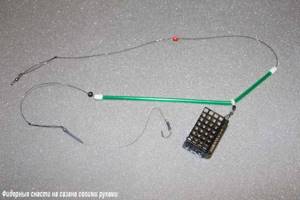
Bait
Suitable bait for carp:
- Boyle (This is a ball of food. It must have a strong, but not pungent odor that will attract carp. Fruit, garlic or honey are suitable as bait);
- Maggot;
- Worm;
- Shell meat;
- Cereals;
- Canned corn;
- Whole peas;
- Pearl barley;
- Boiled potatoes;
- White bread;
- Dough;
- Processed cheese.
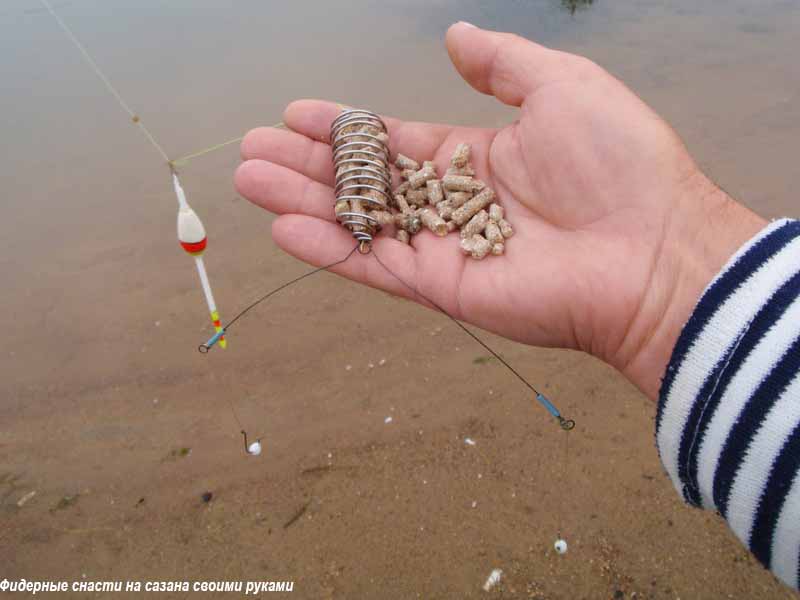
Feeder fishing technique on the current
In case of strong current it is necessary:
- Constantly feed the fish without reducing the amount of bait;
- Choose the right tackle;
- For each design, make stands so that the fishing lines of the fishing rods do not get tangled;
- Install a friction brake on the reel.
Tips for proper fishing
If a feeder is used, consider some factors:
- Fishing spot;
- Feeder class - it depends on the size of the fish you catch;
- Choice of bait;
- Automatic hooker (when fishing with several gears).

The most common habitats of carp:
- Soil with clay or silt;
- A shore where there is a lot of algae;
- Depth, where there are holes and snags;
- Shallow waters where small individuals congregate.
General requirements for all tackle for carp
Carp is famous for the fact that it provides amazing resistance to the fisherman, so the gear must, first of all, be reliable. Moreover, each element is carefully selected and pre-checked.
For the fish in question, float tackle with a “running” rig or bottom tackle is most often used.
The use of a float rod is possible in the following conditions:
- Fishing on the lake from a boat.
- Fishing in deep places of rivers located in close proximity to the shore:
- with a weak current;
- in the presence of so-called return flows (areas of rotational movement of water).
The main requirements for a fishing rod are its rigidity and fast action, the possibility of forced fishing. The most suitable types:
- Spinning - fast action, having an increased test of 80-100 g and a length of 2.7 to 3 m;
- Carp - from 5 to 6 m long.
The specific length depends on the location : while it is more convenient to fish from a boat with a shorter rod, from the shore it is preferable to use a longer rod.
The reel should also be powerful ; a reel with a baitrunner, the so-called “carp reel,” is best suited.
The type of fishing line depends on the chosen method - both monofilament and braided fishing line of various diameters are used for carp.
It is better to prepare special hooks - carp ones, the main difference of which is the way of attaching the bait - not on the hook itself, but next to it. Among the indicated subtypes of hooks, it is also important to choose the most reliable one, and the remaining characteristics of the hook (size, shape, etc.) depend on specific conditions.
When choosing a float , first of all you should pay attention to those that are specifically designed for use at depth . Both the float and the sinkers must be sliding.
For successful fishing, the equipment of the feeder plays a role not so much as the equipment itself. The choice depends on the speed of the current : in stagnant water they use lightweight plastic ones, in small currents - lead ones, a steel feeder makes sense at a very high flow speed.
Thus, the general requirements for equipment are dictated mainly by the strength and resourcefulness of wild carp.
How to choose tackle for catching carp
The criteria that fishing gear intended for hunting carp must meet will become much clearer if you know the peculiarities of the lifestyle and habits of this fish. Carp is sometimes called wild carp, and deservedly so.
Not being a predator, this inhabitant of fresh water bodies, however, has practically no natural enemies. However, we are talking only about adult individuals that reach large sizes (3–4 kg of weight by 2–3 years of age) precisely due to the ability to fight for life.
Did you know? The maximum dimensions of the carp that were ever officially recorded were 1 m in length and 35 kg in weight.
In an active search for food and a constant race for survival, wild carp acquires the necessary experience and becomes a very strong competitor - both in the literal and figurative sense of the word. You can catch such a fish either by luck, which a good fisherman would not count on, or as a result of serious and thorough preparation.
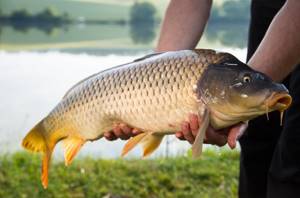
In any case, such prey is definitely not for those who plan to sit in a pleasant company on the river bank, lazily watching a float thrown into the water or a supply left “for luck.”
Once hooked, a brave carp will not give up without a fight and, trying to break free, can easily break even a very strong leash with a powerful throw, and if this fails, it will starve the hunter out, either moving away to considerable distances, or trying to hide under a snag or another underwater shelter, preventing yourself from being pulled to the surface.
To overcome active resistance and retain prey during long and tedious fishing, equipment for catching wild carp must meet the following requirements:
- reliability;
- rigidity;
- strength;
- fast build;
- increased sensitivity.
In addition, to attract fish and improve the bite, it is better to stock up on good bait with special activators, including various pheromone-based additives.
Important! When fishing for carp, literally every element of equipment requires careful selection and repeated preliminary testing. There are no trifles here.
Feeder tackle
Experienced fishermen most often choose bottom gear for the reason that they have to fish from the bottom, and, as a rule, from afar. A modern version of this type of equipment is the feeder, which differs from the bottom fishing rod by the presence of tips called “quivertips”, designed to signal a bite. In addition, the feeder allows the use of special feeders. The rod has guide rings on low holders, as well as thin, replaceable quivertypes with feeders of different weights of varying rigidity.
Rod
The following classes of feeder rods are distinguished: light, medium and heavy. The most universal is the middle class, whose characteristics are suitable for almost all possible fishing conditions. This fishing rod will be optimal for a beginner. Using the feeder test, you can determine the maximum possible amount of gear for a particular class: for light ones - no more than 40 g, for medium ones - from 40 to 80 g, for heavy ones - from 80 g. The class of the rod also determines its structure: heavy ones have a fast action, light ones – slower.
Features of the feeder rod for carp fishing:
- power, elasticity and, at the same time, flexibility;
- with rare exceptions, it consists of two parts, with each connection having a bushing or a pressure gasket;
- material - carbon fiber, fiberglass or bamboo;
- from 6 to 10 rings, installed in order from large to small diameter towards the quivertip.
Whip
The whip (tip, quiver tip) of the feeder rod performs two functions - shock absorption and signaling. The presence of the latter determines the importance of the sensitivity of these devices. Depending on sensitivity, quivertypes are divided into:
- soft - made of fiberglass - necessary in conditions of weak or no current;
- medium – for average water flow;
- rigid - made of carbon fiber - for strong currents.
It is impossible to give clear recommendations for choosing a feeder rod tip; you need to be guided by the individual feeling of the bite of a particular angler. However, it is worth remembering that the whip must support the weight of the intended equipment.
fishing line
For the feeder, depending on the casting distance, both monofilament and braided fishing lines are used. For short distances, monofilament is good; for long distances, braided line is suitable. This is explained by extensibility indicators, which, in turn, affect the transmission of the bite signal to the quivertip. Optimal line diameter indicators:
- monofilament line – for fish up to 1 kg – 0.16-0.2 mm
- for fish more than 1 kg - 0.2-0.22 mm.
- braided fishing line - 0.1-0.16 mm.
Coil
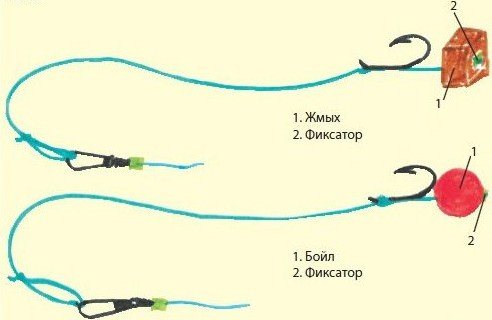
As noted above, a reel with a baitrunner system is optimal when preparing gear for carp. However, it is also possible to use a regular reel with a friction spool, equipped with an anti-reverse and clamp control button. This is convenient when unwinding the fishing line because you do not need to open the line guide.
Feeder
The general requirements for a feeder for catching carp are fully suitable for a feeder. Let us only add that in conditions of significant current, the shape of the feeder plays an important role. In this case, experienced fishermen recommend using a feeder with a rectangular cross-section, which does not roll along the bottom with the current, and also has a larger volume than triangular feeders.
Hooks
When choosing a hook, you must be guided by the following criteria:
- short, durable fore-end with notches;
- durable sting with notches;
- When you pry the hook, it should spring back a little.
Carp reel for catching carp
Carp reel Daiwa Black Widow. Price: 2800 rubles.
Since the carp is a rather large fish, which you will also have to fight with in the current, the choice of a carp reel should be treated no less carefully than the choice of a fishing rod. Add to this the need to cast heavy feeders, and you will understand that when choosing a reel, the first requirement is reliability. The second is the presence of a “bayrunner” system.
Let's take a closer look at the main characteristics of the coil we need:
- gear ratio from 4.1:1 to 4.8:1 (the slower, the easier it is to fish out large carp)
- spool from 4500
- number of bearings from 5 (this is the minimum, if less, then there is a high probability of rapid wear of parts)
- presence of a “bayrunner”
The following models are best suited to the following characteristics:
- "Banax Helicon 500NF"
- "Okuma Power Liner PL-860"
- "Trabucco Kalos CRB 6000 Brass Gear"
- "Daiwa Infinity-X 5000 BR"
- "Salmo Elite Freerun"
- "Shimano Super Baitrunner XTE A"
These reels have the necessary qualities.
The gear ratio will provide you with the necessary balance between traction characteristics and the speed of reeling out the line when fishing for prey. The size of the spool will allow you to cast the tackle further and reel it in faster. The number of bearings will ensure the necessary reliability and trouble-free operation of the reel. “Bayrunner” is a device that allows you to quickly turn off the reel brake. We need this function due to the specific nature of fishing. After the bite, the line will freely come off the reel spool. Thanks to the “bayrunner” system, it is easy to turn off the rotation system with one movement. And you can catch carp.
Makushatnik
Fishing with a makushatnik is an old and proven, and, most importantly, inexpensive and no less effective method, even in comparison with the most modern fishing gear. And carp is one of the connoisseurs of cake.
Sinker. In fly fishing, it is possible to use a very diverse range of weights and shapes. And at stakes and lakes, you don’t even have to use sinkers at all, throwing the top up to 30 meters. If you need to cast further, the weight can be quite small - 50-60 g.
For places with current, the following types of weights are used:
- washer - mainly suitable for still water, but can also be used on a river in the appropriate weight. Weight ranges from 50 to 200 grams, for medium and strong currents the optimal weight is from 120 grams;
- dovetail - a popular sinker model, ideal for currents;
- horseshoe - has a flat shape, has proven itself well on rivers.
Greater stability of the tackle on the bottom will be achieved by following the following rule: pull the top of the rod a little towards the shore to the edge immediately after casting.
Dumpling cube. The quality of the cake plays a major role in fishing with the mascara. Fishermen advise buying ready-made makha, cut into cubes. It can be pure or already with added scent. The density of the cube depends on the intensity of the current at the intended fishing spot: for a current, a denser one is suitable, and for standing water, a less dense top is suitable. The freshness of the material should be the determining factor when choosing a cake.
It is recommended to drill holes in the corners of the crown cube for inserting hooks, but many anglers do not insert hooks and still get the same catch. Immediately before fishing, you can flavor the top. Fruity scents, the smell of hemp, honey, and vanilla are often used.
Bead. The stop bead you need is completely ordinary, medium-sized, and not bright. The bead is attached to the end of the fishing line near the sinker and serves to ensure that the fish that swallows the hook hooks itself.
Fishing line. It is recommended to use monofilament with a diameter of 0.4 to 0.6 mm. It's not easy to predict what size fish you'll be dealing with, but it's still worth checking the vein for tearing. In total, approximately 50 meters of fishing line will be required.
Leashes. A braided line with a diameter of 0.22 mm is most often used as a leash. It is a good idea to use a camel to connect to the main line to avoid tangling the tackle.
According to some anglers, the leader should be soft so that the fish grabs it more naturally. The rigidity of the fishing line plays a bad role in this case. As an option, supporters of this opinion propose making leashes from nylon thread.
The length of the leash varies among different fans of this type of fishing from 4-6 cm to 8-10 cm.
Features of carp fishing
Quite often, fishing for carp feeder is carried out using a method. This is the same feeder, but just like its original version, when the feeder is combined with a sinker. Let's consider the classic method, when the leash is tightly connected to the equipment. The carp, sucking in the bait, is placed on the hook under the influence of heavy feeder gear.
This is also facilitated by a massive feeder, rigidly attached to the forest. The feeder not only has a lot of weight, it is also weighted with lead. It will take a lot of effort to move it at the bottom. Therefore, the larger the fish you hunt, the more massive the feeder should be.
In the classic method, the hook is tied to the feeder through a small leash. Such equipment has proven itself well in those reservoirs that are not rich enough in fish. Nowadays, the method has been slightly modified, replacing the stationary feeder with a sliding one.
Modern method
We mentioned the modern method in the article “Feeder fishing for carp in reservoirs with standing water.” The weight of the feeder was reduced and it was given free movement along the central forest all the way to the swivel with the leash. After throwing the tackle, the hook hits the top of the bait. The method is very effective in silted reservoirs, since the food and bait do not get buried.
Fishing for carp with a feeder is not so difficult; the only condition is the correct equipment. This fish is quite strong and is capable of dragging the form into the water and even breaking it. To avoid this, it is secured with a cord to a peg driven on the shore. You should not fish with several rods at once; it is better to clearly control one.
Some fishing tips
Throwing a tackle and passively waiting for hours for a bite is an ineffective way of fishing. It is necessary to rethrow the rod, checking the bait and bait every 15 minutes. If you do this more often, the fish can be scared.
A short guide to fishing techniques.
- Be sure to try to secure the form after casting, since not only the carp, but also a strong current can overturn it.
- There is no need to make a lot of useless movements if the fish is sitting on the hook; the carp has such a feature as self-hooking.
- Do not relax when fishing, the fish will not forgive the slightest mistake. Strictly control the gear until the very last moment.
On a fast-flowing river, the blank is fixed perpendicularly to increase the sensitivity of the gear. In calm bodies of water, the angle should also be maximum, since the less the line floats in the water, the lower the pressure on it.
How to lure carp
Carp are fed in the same way as regular fish. First, starting casts are made so that the fish tastes the food. During the current, it is necessary to ensure that the feeder does not drift away and that the food ends up in a strictly designated place for fishing. In order to feed correctly, the first few casts are made without a hook. Having thrown the tackle into the desired area for the first time, the fishing line is fixed on the reel so as not to make a mistake in the future with the casting range.
It is possible to lure carp with both plant baits and bait of animal origin. If the latter are ideal in early spring, then in the warm season he prefers corn, peas, boiled potatoes and dough. It is important to remember that the bait and groundbait must be similar in composition.
Float tackle
The basic requirements for the elements of float gear are reflected in the section above, but we will try to add some more specific recommendations.
When using float gear, it is important to feed in large fractions several hours before fishing. For this, you can use a mesh with small cells or a bag, putting porridge or cake in them. Clay balls with peas, corn, etc. are also suitable. The main principle is that complementary foods should be solid and large.
rod (length 5-6 meters) or a rigid fast-action spinning rod with a test weight of 80-100g (length 3 m) is suitable.
A reel with a baitrunner - as a necessary element was described in the section “Feeder tackle”.
Stand. It is better if there is a special carp one, installed at an angle to the horizon.
Monoline. When choosing the diameter of the fishing line, you should remember the same features of the fish species in question (size and strength of resistance provided), thus, the larger the diameter, the greater the likelihood of achieving success. The optimal line diameter is considered to be from 0.25 to 0.3 mm; this is quite enough to pull out a fish up to 10 kg.
A thicker line will alert the fish, and, in addition, it will be carried away more strongly by the current. As for the type of fishing line, experienced fishermen advise not to take a braided one, which is not able to compensate for strong jerks due to the lack of stretchability.
Among its disadvantages is also the fact that the “wicker” tends to collect a larger amount of mud and is often cut by sharp elements of snags and hogs overgrown with shells. The leash, as usual, is made from fishing line of a smaller diameter, for example, 0.23-0.25 mm.
The leash needs to be very long: from 0.3 to 1 meter. In addition, you should put pellets on it so that it lies at the bottom: a smart and cunning object of the hunt will certainly notice the fishing line stretching upward.
Carp hooks must be selected with a short shank and a sting on the side. Numbers from 2 to 6 are recommended.
The float is selected sliding, specially adapted for depth. At the same time, its carrying capacity is practically unimportant, since the depth is always set greater than it actually is. More attention should be paid to camouflage the float in color and size.
The sinker used is not heavy.
Time and place of fishing
Carp in the Volga delta is caught from the second half of April to September inclusive. But the most productive fishing for wild carp takes place from the end of June to the end of August. According to popular belief, the zhor of carp coincides with the ripening period of apricots. The best bite usually occurs at dawn and in the early evening hours.
Sometimes wild carp come in search of food to small areas of the Volga channels with dense coastal vegetation. An excellent indicator of the location of the carp are ringing morning splashes, reminiscent of the blow of an oar on the water. If such a place is found, then we can assume that the carp’s “dining room” has been discovered. Another sign is the appearance of bubbles on the surface of the water, which indicate the presence of a school of wild carp at the bottom of the reservoir.
We invite you to familiarize yourself with Saltirolia or Helxina: care at home, flower propagation by cuttings and seeds, photo
• bottom tackle from a boat;
• bottom tackle from the shore;
• float tackle from the shore.
Bottom fishing from a boat is considered the most practical. The fishing tactics in this case are as follows: the fisherman anchors in a promising place, casts his gear, feeds and waits for wild carp to approach a promising place. First the whitefish pecks, then the pecking stops. This means that a serious guest has arrived at the feast and you should prepare for a more serious bite, which will not take long to arrive.
To catch wild carp in the lower reaches of the Volga from a boat, the following gear is required:• a picker rod with a test of approximately 100 grams and up to three meters long;• a spinning reel numbered 3000, equipped with braid numbered 1.5# (0.2 mm in diameter);• a nipple or paternoster rig. ;• leash 50-70 centimeters long made of 0.25 millimeter fishing line and hook No. 2 (No. 9 according to Russian numbering).
When fishing with bottom gear from the shore, it is advisable to use two or three feeder gear at once. It will be more reliable if the tackle for coastal fishing is slightly strengthened: • a powerful feeder rod with a length of four meters and a test of approximately 150 grams; • a reel with number 4000; • a leash with a diameter of 0.3-0.35 millimeters and a hook No. 1-1/0 (No. 10: 12 according to Russian numbering).
Float tackle is intended for fishing close to the shore along vegetation and by its nature implies lighter equipment:• a Bologna rod 5-6 meters long and a spinning reel with number 2000;• main line with a diameter of 0.25 millimeters;• float with a carrying capacity of 3-5 grams;• leash with a diameter of 0.2 millimeters and a hook No. 6-5 (No. 7-7.5 according to Russian numbering).
In all options, special attention must be paid to the clutch - it must be properly adjusted. Without adjusting the friction on the reel, catching carp is pointless: after the first jerk, the equipment will be torn off. When fishing for carp, the presence of a landing net is mandatory. It is almost impossible to pick up a wild carp from the water with your hands.
In any situation, when fishing for carp, silence and camouflage are necessary: any sound can scare away cautious fish for a long time.
Bait and groundbait The following can be used as bait for wild carp:• worms and crawlers;• chafer larva;• toothless shell meat;• crayfish meat;• corn;• mastyrka;• boiled potatoes;• wheat porridge;• boilies.
As bait, you need to use various cakes, breadcrumbs, steeply brewed porridge, mixed feed, and purchased bait. In addition to using a feeder, it is advisable to feed the fishing area more thoroughly. When fishing from a boat or from the shore with a float rod, you also need to feed it manually.
Catching carp is a real test of a fisherman's character. In order to adequately fight Astrakhan wild carp, the fisherman must have perseverance, endurance, composure and determination. Therefore, in order to win a battle of characters against the carp, the hunter must be armed with at least minimal experience.
In early autumn, it is better to start fishing around 7 am; at this time large specimens are most often bitten. Fishing for carp is allowed from morning until lunch. The evening bite will be sluggish and unenergetic.
In late autumn, at this time of year, there may be night frosts, so it is better to fish from 10 o’clock to 13-14 o’clock. During these hours, the temperature rises and the carp begins to actively feed.
In spring and early summer, Akhtuba overflows, covering all floodplains with water. The carp spreads across all floodplain zones, and it becomes difficult to find it. In the summer, Akhtuba enters the banks and the bite is restored. But due to the heat, the carp feeds at night or at dawn. Therefore, fishing is productive only during these hours.
Carp in the Volga delta is caught from the second half of April to September inclusive. But the most productive fishing for wild carp takes place from the end of June to the end of August. According to folk signs, the zhor of carp coincides with the ripening period of apricots. The best bite usually occurs at dawn and in the early evening hours.
The home of the carp is a deep pool, very often snagged. It is not advisable to catch it directly in the pit itself - immediately after biting, the fish with the equipment will go into the snag, and getting it out of there will be very problematic. It is much more productive to lure wild carp out of their hiding place. Therefore, the most promising places will be upstream from the snags - edges, reaches, underwater hills, boundaries of shallows, deep channels with reverse flow, bottom areas with large stones. The depth in such places can range from 2 to 6 meters.
We suggest you read: Are frozen berries and vegetables as healthy as fresh ones?
Sometimes wild carp come in search of food to small areas of the Volga channels with dense coastal vegetation.
An excellent indicator of the location of the carp are ringing morning splashes, reminiscent of the blow of an oar on the water. If such a place is found, then we can assume that the carp’s “dining room” has been discovered. Another sign is the appearance of bubbles on the surface of the water, which indicate the presence of a school of wild carp at the bottom of the reservoir.
Bottom tackle
The length of the bottom fishing rod is determined by the fact that most often casting is done from a boat. In this case, a length of 2.5-2 m is considered successful. The choice of reel does not play a special role, however, as in previous types of fishing, a powerful reel is desirable.
The length of the fishing line wound on the reel should be from 30 to 45 meters. It is better to take a monofilament line, if possible, that matches the color scheme of the bottom. The sinker, depending on the strength of the current, can weigh 40-80 grams for a weak one, and from 80 to 100 grams for a strong one. A suitable leash length is 25-40 cm, line diameter is 0.3-0.4 mm. The hook you need again is a carp hook, approximately No. 2.
When fishing with a bottom fishing rod, it is important to use durable baits such as a worm or unsteamed cake. The nozzle is placed on the hook arbitrarily. In this case, bait is not required.
Spinning
Spinning is not the most popular means for catching carp, but with its help you can achieve some success.
rod is chosen to be durable (test from 60 g), equipped with a powerful reel and strong fishing line.
Bait . Most often, a vibrating tail mounted on a jig head, 7-8 cm in size, gives the desired result. The color of the bait should remind the fish of food, so we use soft colors - brown, dark green. You can soak it in flavors.
Which bait and bait should I choose?
Carp is very voracious and eats everything that can be eaten around it. However, the most popular bait for catching it has become a worm. Crawlers and dung worms are most suitable . In second place are plant attachments, the list of which is very large:
- porridges: millet, pea, corn, semolina, etc.;
- bread crumb with crust;
- dough
- potato
- cake
- pasta, etc.
Of course, he will also like various types of boilies.
The bait used is also different. The basic rules are to feed with large fragments, do not overfeed.
Lures
Boilies The Grave Pop-ups
Now we need bait - it determines whether our fish will swallow the hook or not. Consider the five most popular:
- Mix the crumb of black bread into a homogeneous mass with processed cheese. Roll into balls and string onto a hook.
- Pour water over the corn and boil. Let it brew for 12 hours. Thread the grains onto the hook.
- Mix the bread crumb with the boiled potatoes. Add a couple of drops of unrefined sunflower oil. Roll into balls and string onto a hook.
- Cook the peas for no more than half an hour (so as not to overcook them). We string the grains onto a hook.
- We make a stiff dough from wheat flour and water. Roll into balls and fry them in unrefined sunflower oil. Thread the resulting bait onto a hook.
- Boilies, how to catch carp and carp with boilies and how to choose them correctly is described in this article.
After we have chosen a rod and reel, prepared the fishing line and tied the equipment, prepared the bait mixture and bait, we can go fishing for carp itself. In order for our efforts not to be in vain and our fishing to be productive, we must choose the right place for fishing.
Fishing technique
The technique for catching carp varies depending on the type of gear, as well as the experience of the fisherman. Let's list the basic rules and techniques:
- Be sure to secure the rod after casting.
- The carp hooks itself, so you shouldn’t make unnecessary movements after the fish grabs the bait.
- If a fish caught on a hook goes under a snag, you should not pull it out, you should fasten the rod again and wait until it comes out on its own.
- The carp resists to the last, so you need to lead him confidently and calmly until the very end.
Bait for feeder fishing for carp
Cereals are suitable as bait. Note:
- The smell should not be too strong so that the fish are not scared;
- Grind the cereal. Due to this, the water will become cloudy, the field of view of the fish will decrease;
- The bait must be solid.
The cereal must first be boiled and wait until it cools. Clay is added to the bait. For every 100 grams of bait - 200 grams of clay. Treat the mixture with sunflower oil or special solutions that are sold in fishing stores.
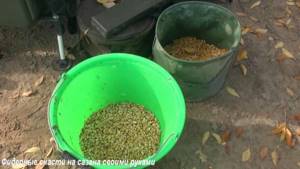
If there is no current, you need to leave the bait in advance - about a day before fishing. If there is a current, bait can be applied directly during fishing.

